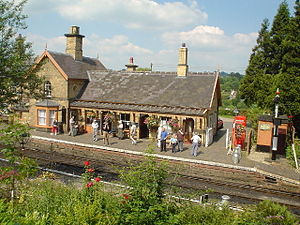Arley
| Up (towards Kidderminster) | Down (towards Bridgnorth) |
|---|---|
| Bewdley (3¾ miles) via Northwood Halt |
Highley (2¼ miles) |
Contents
The Station
Arley station has two platforms and a signal box, allowing trains travelling in opposite directions to pass.
Barrow crossings are located at both ends of the platforms, but may not be used by the general public. Bridge 17 is located at the south end of the station, immediately south of the barrow crossing, and is the main passenger route between the platforms. Skeet's Farm crossing is also located in the station area, immediately north of the goods yard.
During periods of lighter traffic, when Arley signal box is switched out, all trains use the platform adjacent to the main station building.
The village itself is named Upper Arley, which differentiates it from the similarly named, but differently spelled Areley Kings less than six miles away near Stourport.
Photos at Arley, showing station building, signalbox & gardens
Facilities
Arley station does not have a public car park. There is a small cafe building behind the station which serves hot and cold drinks and snacks.
Points of Interest
Station buildings
The main station building at Arley dates from the opening of the Severn Valley Railway in 1862. Extensions were later added, consisting of a Ladies waiting room authorised in 1892 and an additional bedroom in the Station Master’s house added in 1901.
The shelter on Platform 2 is also original, dating from the opening of that platform in 1883.
The café building behind the station was built during the summer of 1992 on the site of the former weighbridge.
Restoration
When the SVR first re-opened the line between Hampton Loade and Bewdley in 1974, there was no facility to pass trains, the Up loop (the running line nearer the station building) having been removed by BR in the 1960s. This was re-laid over the next year and re-opened on 25 May 1975.
Arley history before preservation
- 1862: Arley station opened with the rest of the Severn Valley Line on 1 February, but had only one platform and no facility for crossing trains. Control of train movements was by single needle telegraph only
- 1883: A second platform was brought into use in June 1883. Installation of a signal box and interlocking of points and signals were completed around this time.
- 1891: ‘Train staff and ticket’ working in conjunction with a single-needle block telegraph was introduced throughout the line, replacing the earlier simple telegraph working arrangements. Henceforth drivers could not enter a section without possession of a physical staff or paper ticket stating the staff would follow on a succeeding train. Those used at Arley were for Arley to Bewdley North (hexagonal staff, yellow ticket) and Arley to Hampton Loade (square staff, red ticket).
- 1894: ‘Electric staff’ working replaced staff and ticket working. Highley also became a staff station, breaking the long section to Hampton Loade.
- 1898: An accident occurred when a train overran signals when entering the station and was derailed.
- 1907: The platforms were lengthened and the up platform widened.
- 1913: Following the building of a signal box at Kinlet and Billingsley Sidings, Arley to Kinlet (when switched in) was worked by electric staff but Arley to Highley was worked by electric tablet, probably Tyers No 7.
- 1938: A GWR camping coach was based at Arley.
- 1950: By this date, Electric Train Token working had been introduced, becoming the fifth method of train control.
- 1963: Through passenger services ceased on 9 September, with through freight services ending at the end of November.
- 1964: The signal box closed on 28th June. The up line and sidings were lifted, and the edge of the down platform was removed to give greater clearance for coal trains from Alveley. The original signal box was later demolished.
Gallery
An ex-GWR Prairie calls at Arley in October 1959 (Sellick Collection)
Pannier 3619 calls at Arley in September 1962 (Sellick Collection)


